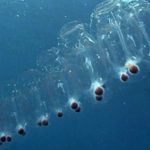Grant lets marine biologist pursue bioinspired study of jellyfish
Biology professor and marine biologist Kelly Sutherland from the University of Oregon has been awarded $1.1 million over three years from the Gordon and Betty Moore Foundation. The project she is working on focuses on how jellyfish must work together to swim in the ocean. She is also working with other organisms, such as gelatinous worms and snails. Sutherland believes they are the most effective swimmers in the ocean. These animals filter water in order to move and also to take up food. From the bio-inspired angle, Sutherland wants to understand how these jellyfish swim to improve underwater transport. She hopes to learn more about the shape of the colony as it moves through the ocean and how the pattern of the water changes as the organisms swim through. So far, a surprising discovery is that there is no pattern of propulsion. They do not pulse at the same time but rather pulse at different times. This allows the cony to have a continuous and maintained movement. It will be interesting to hear about new discoveries made in this lab in the next few years and how it might change the design of underwater vehicles.
Learn about our two Decals!
 Click here to find out more about our Fall Bioinspired Design Decal and our Spring Bioinspired Design in Action Decal – ALL MAJORS are welcome.
Click here to find out more about our Fall Bioinspired Design Decal and our Spring Bioinspired Design in Action Decal – ALL MAJORS are welcome.Berkeley BioDesign Community
 Click here to learn about the BioD: Bio-Inspired Design @ Berkeley student organization or here to signup for more info.
Click here to learn about the BioD: Bio-Inspired Design @ Berkeley student organization or here to signup for more info.Search
Student Login




I imagine that the neurological circuits underlying these processes are governed by both 2d spacing maps with their brains as…
to reduce the impact of car accidents, it may be possible to study the force diverting physics of cockroaches to…
you see this type of head-bobbing stability in many avian creatures related to pigeons like chickens. the head ability to…
not like they taught horses how to run! this is an example of convergent evolution where both sea creatures and…
The brain functions in a similar way with neuronal connections. our brains are able to utilize the multiplicity of connections…